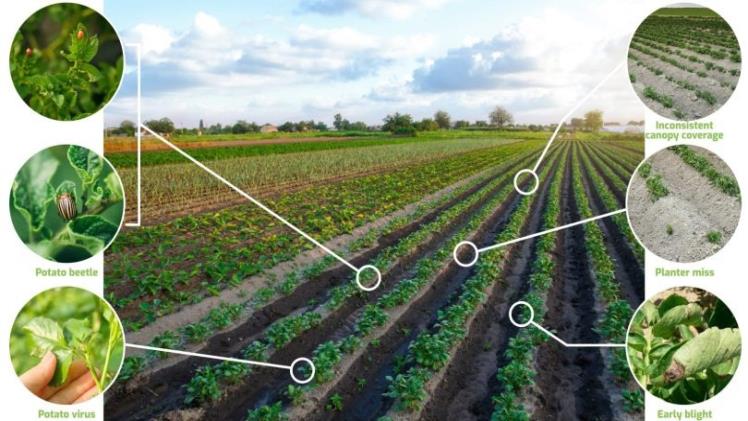In the modern age of agriculture, where precision and efficiency are paramount, remote sensing and satellite technology have emerged as powerful allies. These technologies, bolstered by sophisticated satellite imagery and remote sensing techniques, have revolutionized the way we monitor crops, assess their health, and predict yields on a large scale. This marriage of cutting-edge technology and agriculture not only facilitates precise decision-making for farmers but also plays a pivotal role in ensuring global food security.
Understanding Remote Sensing and Satellite Technology:
Remote sensing involves the collection of data about an object without direct physical contact. In the realm of agriculture, satellites equipped with various sensors capture data about the Earth’s surface, including crop fields. These sensors can detect a wide range of electromagnetic waves, from visible light to thermal infrared, enabling them to gather diverse information about crops and their surroundings.
Satellite Imagery for Crop Monitoring:
Satellite imagery provides a bird’s-eye view of agricultural landscapes, offering valuable insights into crop health, growth patterns, and potential issues. High-resolution satellite images capture detailed information about crop density, soil quality, and moisture levels. By analyzing these images, experts can identify variations in crop health, allowing for targeted interventions.
One of the significant advantages of satellite imagery lies in its ability to cover vast agricultural areas in a short period. Traditional methods of ground-level monitoring are often time-consuming and limited by accessibility. Satellite technology transcends these limitations, making it possible to monitor extensive farmlands across regions and countries.
Remote Sensing Technologies for Crop Health Assessment:
Remote sensing technologies, such as hyperspectral imaging and Light Detection and Ranging (LiDAR), provide detailed information about crop health. Hyperspectral sensors detect a broad spectrum of light, allowing for the identification of specific wavelengths associated with healthy and stressed plants. This level of granularity enables precise diagnosis of diseases, nutrient deficiencies, and pest infestations, empowering farmers with actionable insights.
LiDAR technology, on the other hand, uses laser pulses to create detailed 3D maps of crop fields. By measuring the distance between the sensor and the Earth’s surface, LiDAR can accurately assess crop height and structure. This information is invaluable for predicting yields, as taller, well-structured crops tend to produce higher yields.
Predictive Analysis and Crop Weather Outlook:
Satellite technology not only provides real-time data but also supports predictive analysis. By integrating historical satellite data with weather patterns and other environmental factors, scientists can develop sophisticated models that forecast crop yields. The integration of crop weather outlook data into these models is particularly crucial.
Crop weather outlooks incorporate meteorological data such as temperature, precipitation, and humidity, which directly impact crop growth. By analyzing these weather patterns alongside satellite imagery, researchers can anticipate the effect of climate variations on crop health and yield. For example, prolonged periods of drought or unexpected frost can significantly affect crop yields. Predictive models that consider these variables can provide early warnings to farmers, enabling them to implement adaptive strategies, such as adjusting irrigation schedules or selecting more resilient crop varieties.
Benefits and Impact on Agricultural Sustainability:
The utilization of remote sensing and satellite technology in crop yield prediction offers a myriad of benefits. Firstly, it enables proactive decision-making. Farmers, armed with real-time and predictive data, can optimize their agricultural practices. They can precisely target areas that require additional care, whether it be irrigation, fertilization, or pest control, reducing unnecessary resource usage and minimizing environmental impact.
Secondly, these technologies enhance resource management. By accurately predicting yields, farmers can plan their harvests efficiently. This knowledge is invaluable in determining storage requirements, transportation logistics, and market strategies. Minimizing post-harvest losses is essential for sustainable agriculture, ensuring that the efforts put into cultivation translate into actual food supply.
Additionally, the early detection of diseases and pests through remote sensing technologies prevents widespread infestations. By identifying problem areas swiftly, farmers can implement localized treatments, curbing the spread of diseases and reducing the need for extensive pesticide use. This targeted approach promotes ecological balance and safeguards both crop health and environmental sustainability.
Challenges and Future Directions:
While remote sensing and satellite technology have undeniably transformed agricultural practices, challenges persist. Ensuring the accessibility and affordability of these technologies for small-scale farmers, particularly in developing regions, remains a concern. Bridging the digital divide and providing training to farmers on utilizing these tools effectively is essential for inclusive agricultural development.
In conclusion, the role of remote sensing and satellite technology in crop yield prediction dataset is transformative. By harnessing the power of these technologies, we empower farmers with knowledge, enhance agricultural productivity, and promote sustainable practices. The fusion of satellite imagery, remote sensing, and predictive analysis, including the integration of crop weather outlook data, creates a synergy that drives agricultural sustainability, ensuring that our agricultural landscapes are not just productive but also resilient in the face of a changing climate. As technology continues to advance, the marriage between satellite technology and agriculture will only grow stronger, ushering in an era where every harvest is optimized, and global food security is a shared reality.


